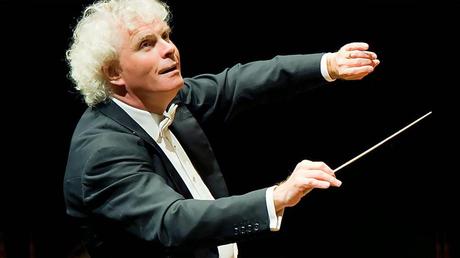by Paul J. Pelkonen

Sir Simon Rattle.
Photo courtesy the Berlin Philharmonic © 2014 Berlin Philharmonic.
The concerts are also part of an effort to promote the Philharmonic’s swanky new boxed set of Schumann symphonies recorded with music director Sir Simon Rattle, the orchestra’s first such endeavor under its new Berliner Philharmoniker brand. Sunday's concert featured Symphony No.1 and No. 2, chronicling very different episodes and states of emotional being in Schumann’s short, stormy life.
The Symphony No. 1 ("Spring") bursts with optimism. 1841 saw the composer’s long awaited marriage to Clara Wieck, and the start of a new creative direction as he began to shift his attentions from piano and lied to the full orchestra. There is a sense of creative frenzy in the First, a work that the composer sketched out in just four days.
Sir Simon elected to use Schumann’s unrevised orchestrations. From the opening shout of trumpets, the first movement was filled with bustling energy, with the brass taking the lead supported expertly by the strings. Sir Simon urged the players forward, but the results were not hurried. The slow movement allowed oboe, cellos and flute to the fore, with the pared down Berlin orchestra creating a sweet, almost chamber-like texture with room for the brief solo cadenzas to shine.
Schumann was at once a novice symphonies and a fierce iconoclast, and nowhere is this better shown than by the rapid shift to the third movement. This Scherzo was marvelously played, with firm timpani strokes accentuating the rhythm and a sense of kinetic force throughout. The finale, which anticipates Mahler in its depiction of the arrival of spring, was a thrilling climax, capped by the return of the brass theme from the first movement.
The Second Symphony (1846 and technically the composer’ third) stands in opposition to the First. In this far-reaching, troubled work, Schumann draws from the creative heritage of Germanic music, refracting the formal ideas of Bach, Haydn and Beethoven through the cracked lens of his own troubled psyche. The work, sketched in just six days as the composer battled depression is a gloomy journey through a mind troubled with psychiatric issues that were well beyond the medical science of the 19th century.
Sir Simon led a probing, dramatically compelling performance that explored Schumann’s neuroses while still allowing the music to make its own statement. Here it was the slow movement that proved to be the most compelling, with heart-rending, slightly dry double reeds and a stark, wintry fugue, the sound of centuries of musical tradition being turned on its ear.
This sense of queasy uncertainty permeated the finale. Its ending, in a blaze of brass and orchestral color seemed somehow false, the sound not of triumph over tragedy, but a brief and illusory respite. I'm this penetrating interpretation, conductor and orchestra Schumann as more than a romantic. This was the sound of an original mind, whose symphonic writing presaged the troubles of the century to follow.

